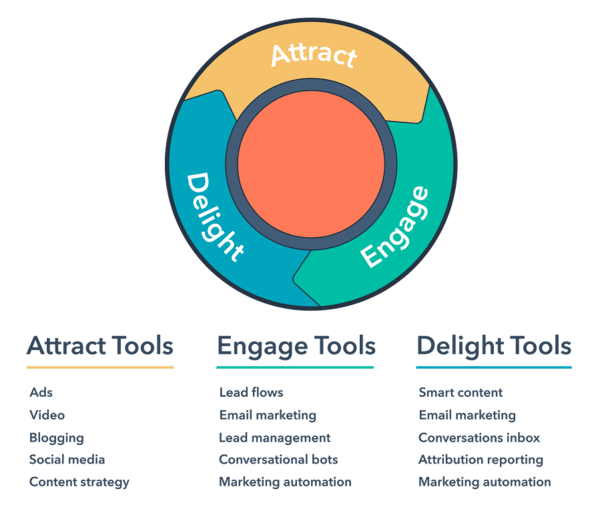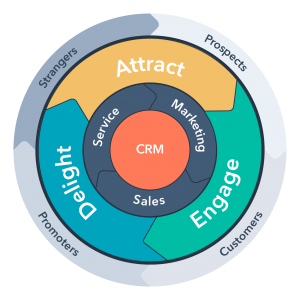Inbound marketing uses a subtler set of strategies compared to traditional outbound marketing techniques. It’s also a necessity for businesses that want to build a successful brand and stand apart from the competition.
Inbound marketing draws your customers to your products and services through the creation of content and campaigns that delight your target audience and transform them into brand advocates. For example, social media campaigns, SEO (Search Engine Optimisation) and content marketing are all core strategies under the inbound marketing umbrella.
Outbound marketing, on the other hand, tends to use more direct tools such as direct mail, telemarketing and events. However, research reveals one-third of marketers think outbound marketing tactics such as paid advertising are a waste of time and resources.
Further research reveals more than half of marketers realise a higher ROI with an inbound marketing strategy, compared to outbound. And 59% more leads are generated by inbound marketing than traditional marketing methods.
The growing popularity of inbound marketing is a result of changing consumer behaviour patterns. For example, 79% of people online now use Facebook, Snapchat has 229 million daily active users and product videos can increase purchases by 144%.
The inbound methodology is a multi-stage process where strangers are turned into customers and, ultimately, promoters of your business. This transition occurs over three basic stages: attract, engage and delight.

Within each stage, there are a number of strategies you could use to push consumers further down the sales funnel. There are many types of inbound marketing but here are seven core elements:
1. Goals
It’s important to set clear goals to understand what direction you want your business to go, and how your inbound marketing strategy can help you achieve those goals. To start with, formulate an inbound marketing mission statement to set the tone for your inbound marketing. Then, you can drill down into your specific goals and KPIs.
For example, you may want to start to build a wider gameplan. Here, you should review, analyse and interpret your web traffic and Google Analytics data.If you don't have Google Analytics set up, then it’s a good idea to implement this so you can start tracking your traffic.
Next, you need to review (or estimate) your required traffic and lead requirements to fit with your business and growth objectives. Discuss how much you need to achieve with your marketing efforts to meet your goals in terms of traffic, leads and new customers.
Finally, you should discuss possible solutions and look at your budget, resources, and timeframes to integrate all of this into a final marketing game plan for your business.
2. Buyer Personas
Buyer personas are a key inbound marketing tool, which depict fictional and generalised representations of your ideal customers. As a result, you’ll better understand your customers, be able to identify their goals, needs, priorities and challenges, and better connect with them.
There are a range of different ways to create your buyer personas. A good place to start is by asking your current customers questions about their preferences and buying habits and go through your current customer list to uncover any trends. Hubspot also offers a free Make My Persona Tool.
Once you have perfected your buyer personas, these will better inform your inbound marketing strategies and help you to produce content that’s targeted to these user groups.
3. Content Marketing
Content marketing is one of the most essential methods of any inbound marketing strategy. It’s the production of valuable and educational content that’s relevant to your customers and your buyer personas.
55% of marketers say blog content creation is their top inbound marketing priority. However, your content may come in many different forms, including case studies, white papers, eBooks, videos, cheat sheets and infographics, for example. Some 17% of marketers also plan to add podcasting to their marketing efforts in the next 12 months.
Good content marketing will draw more people to your website. For example, research reveals companies that published 16+ blog posts per month got almost 3.5 times more traffic than companies that published zero to four monthly posts. Content marketing also gets three times more leads than paid search advertising.
A content map will help to coordinate your approach here and ensure you produce unique content that stands out in Google’s Search Engine Results Page (SERP). As a simple first step, you could collate all your content ideas, tweak and refine them, for example.
When you have a content map, take these ideas and align with your persona targets, their buyer journey and the topic areas. This will help inform your social media approach, your SEO strategy and keyword targets. A content calendar is another useful tool with recommended ideas and an ideal structure.
Good content management is an ongoing process. So, it’s important to create a long term content plan as this will help you to identify and organise your campaigns, and will also allow you to monitor your results.

4. Website
Your website is your digital shop front and your lead generation machine. You need to ensure your website is inbound ready so you can convert the traffic that your generate when directing new and existing customers to your website.
You will need to create valuable content for each persona on each stage of their journey to achieve this. For example, your homepage is the first page many new visitors will see and, as such, it should speak to your buyer personas. Don’t focus on what you offer, but who you are helping and how you will help them.
You should also provide valuable content and incorporate clear calls to action for those visitors that are ready to contact you or buy from you as soon as they land on your webpage. Also, make sure your site is optimised for mobile devices and your navigation is clear to create a seamless user experience.
5. Social Media
Social media gives marketers the power to tell their business’s story but it’s important to find the right platform (or platforms) for your company. Your buyer personas should make it easier for you to identify the right social media fit for the specific needs and interests of your target audience.
There are a number of ways to attract new customers to your site using social media. For example, you should share and promote your content on social media and create a social media promotion plan to distribute your content to the right people, analyse your content’s performance and pay to promote specific content through, for example, Facebook ads that incorporate clear CTAs.
6. PPC
PPC (Pay Per Click) is an inbound advertising model where you pay a publisher when your ad is clicked. Google Ads are a popular option with 65% of people clicking on these ads when they are looking to buy an item online.
At first sight, PPC may not sound like a fit with the inbound model as it’s a paid strategy. However, it is technically still part of the inbound family since search ads appear when a user is actively searching for you product or service. In other words, a PPC ad does not interrupt another activity for the user.
There are many benefits of PPC marketing. The results are easy to measure and track, it works well with other marketing channels, helps improve your search engine rankings, provides a wealth of useful data and you can use it to target mobile searches.
7. Emails
Lead nurturing emails are the perfect way to keep in touch with your prospects after conversion and to build a better relationship with your customers. Such emails should delight your buyers at the end of their inbound marketing journey.
Automation is a useful tool to send out your emails and help you keep in touch with people to transform them into a sales-ready lead at the right time. It’ll also boost the productivity of your sales team - research reveals that marketers spend just 44% of their time on their primary job duties. The remaining 56% of their time is devoted to email, meetings, administrative tasks and interruptions. So, you may want to bear automation in mind for a range of your repetitive internal processes - not just your marketing emails.
These emails should bring users back to your website and have a defined goal. So, make sure you are providing your users with valuable content and a clear CTA. For example, you may want your users to read you latest blog post, reply to a question or check out your latest product. Furthermore, you could email them to increase customer loyalty by, for example, sending them a birthday message.
In conclusion
Inbound marketing is changing the face of the marketing industry. When asked which marketing tactic provides higher quality leads for the sales team, 59% of marketers responded inbound, and only 16% said outbound. Further research reveals ALL of the most valuable content marketing types for moving prospects through the sales funnel is inbound marketing content.
At Angelfish Marketing, we’re inbound experts and can provide your business with a full inbound marketing review. If you’d like to find out more about our inbound marketing professional services and sign up for a no-obligation health check, please click here.









